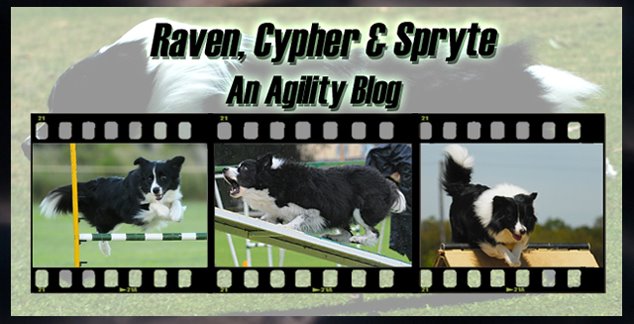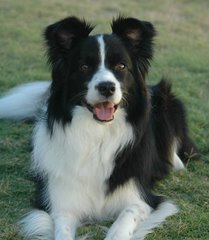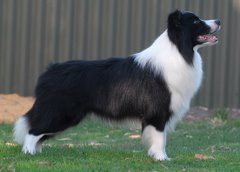The first seminar was held on Thursday and it ran for 5 hours and was for the dogs about to start trialling or in their first 12 months of trialling. The first drill and many subsequent drills he put up for us were from the double box work Greg is so well known for.
Greg got us all to do this drill first up. He then sat us down to talk about some of his handling theory. Amongst many things he mentioned the points that stood out the most were (and like all these things they seem so simple you ask yourself ‘Did I just have a total mental blank here or why didn’t I see this?’) that wide turns are a very strong indicator of the dog not being properly reinforced in the reinforcement zone. That zone being that semi circle shaped area in front of your body and to the sides of your body. I never really thought about defining that reinforcement area as so cut and dried, however the way Greg talked about the zone made it clear that for him the place the dog should always wants to get to and is trying to get to is that reinforcement zone (if of course you have reinforced enough!). This placed quite a new slant on things for me and showed that I have been a very much obstacle reinforcing type trainer when I think back to how I trained Raven. Sure she gets food when she finishes her run, however whilst running sequences, training drills etc I have never really asked her to come right into me and be full on rewarded for it….I multiple treat on contacts, I go in and treat nailed complex weave entries, I have on a few occasions rewarded her for pulling off something when asked, but I have been made wary of this because she has become hyper responsive to it on some occasions pulling off at just the slightest movement (which is where Greg’s talk about consistency revealed a few problems). Cypher is different in a good way if you look at him according to Greg’s theory however I know that his highest reinforcement zone is around the tug toy instead of me but at least he’s not obstacle reinforced….I just have to transfer that toy fixation to me! He always brings me his toy to play at the end but his mission is – finish obstacles> must get toy!! So by rethinking where the highest reinforcement should be you end up having some very different goals in training that’s for sure!! He explained that the front cross for all of us needs to become more ingrained and natural, it is three simple steps but we should be practicing by ourselves out on a field somewhere till we can do them with our eyes shut, running flat out. He noticed our front crosses were happening way too early and this also resulted in us using pre-cueing techniques which he flatly told us were a waste of time and confusing ultimately for our dogs. We were good at rewarding our dogs at the finish but we needed to look at where we were rewarding them (ie there should be no throwing of toys as the reward should come from you and be around you), he was also happy for us to use the next three days to go back and reward the startline waits we got from time to time. Going back to the early front crosses he talked about knowing your dog’s commitment point to a jump and how it can vary throughout a career and that this is something that is quite naturally occurring so therefore he hasn’t seen it been altered too successfully by any special training methods. The ideal commitment point for Greg was at the takeoff point for the dog. This I found curious as it has an impact on how fast a handler can move onto the next obstacle, the commitment point came up again in a later workshop.
Greg then went on to elaborate about front crosses and why we do them, we did them in the above drill to change sides primarily and he did say this was one indicator a Fx was needed (ie that you needed a change of side). We then discussed – did you need to do one from 6 to 7 in that drill as a few people did. Greg said there wasn’t one needed there and used the reason that no change of side was required.
The handler is facing north in this diagram to help give the picture of what Greg was talking about. Basically as you run a course the dog should never cross that line and you can imagine it as this invisible line that runs out from both of your shoulders as you run….often when we get in front of the dog our dogs should be striving to get to our reinforcement zone. So it is quite possible and highly desirable that our dog is always driving in a forwards direction when we are in front to try and get there. Of course for most handlers with fast dogs we are the ones striving to keep that blind cross line moving forward from obstacle to obstacle. The 5 reasons why we shouldn’t do blind crosses on our dogs were given as follows; 1) You take your eye off your dog 2) It lowers their drive forward causing them to shut down 3) It forces them to cross your blind cross line in the wrong direction 4) It is often characterised by a late physical cue and 5) It is a major inconsistency for the dog in handling. Also on the blind cross it was brought up about how whenever Greg is interacting with his dogs he doesn’t let them do a blind cross on him, whether they’re going out for a long walk or just mucking around in the living room he will always block them from doing that blind cross and discourage it from an early age. He mentioned that this is very important with our herding breeds who often find that behaviour so reinforcing and it does show on the agility field, as Greg is a firm believer that behaviours do transfer across (hence he recommends never teaching the finish in obedience around the back of the handler). He said 7 to 10 years ago you may have found dogs in the top levels who were good across disciplines but these days in agility if your dog is a serious herding trial dog or top level obedience or top level flyball competitor you will never reach the top level in agility as well at the same time. There are too many dogs just solely agility dogs that have far better performances in agility. This was interesting….how many times on walks do my dogs cast out around me and come up from behind running at full speed for the frisbee I’m about to throw! It was definitely food for thought and probably threw the challenge down for some really driven dogs there with handlers that do compete in herding, obedience as well.
The 3rd drill we did on the double box is shown in the diagram below;
This we completed with one front cross only between 5 and 6. If the front cross was executed nicely I believe we had our medium and large dogs bounce jumping 5 to 6 smoothly. Greg spoke about our front cross moves and how the foot work needed improving (it should only be three steps; one forward, one back and one forward and should cover a decent amount of ground space – Greg’s is about 2.5m) and also reminded us that our precueing was not required if the dog understands your body cues well and that in actual fact it was the use of the evil arm. He also talked about our diagonal lines needing to be neatened up which refers to the actual placement of our feet on the cross. Dogs that were used to being handled by “Motherflicka handlers” as he so endearingly labelled them, they actually flicked off to the left over jump #2 if the handlers tried to bring up their right arms to straighten the line from 6 to 7. It did actually bring home how inconsistent our handling was by highlighting to us on the one hand when we bring our off arm up we are getting ready for the dog to turn into us, and yet when we are struggling to get to where we need to be we will bring that off arm up in the hope that the dog turns away from us to do the obstacle. I believe there are 4 front cross drills he does that are all about getting those positional cues right. They are as follows;
7 Reasons Why You Should Not Front Cross on a Straight Line
- 1) It is the positional cue for serpentine handling (he prefaced this one with a promise to elaborate further when we go onto serpentine handling)
- 2) It causes the dog to take extra strides nine times out of ten.
- 3) You are teaching your dog to ignore the front cross cue.
- 4) Strong possibility of the dog running into you (this is true I’ve seen it happen on at least a few occasions, plus I’m sure it’s happened to me!)
- 5) Slows the dog down
- 6) Affects the dogs jump arc (ie causes dropped bars)
- 7) Did anyone else get this one? (Cathy?)
So there you go. No more front crossing on a straight line (even if you do have to change sides!!). One rule I’m going to try and stick to as it certainly makes sense to me, not that I am a notorious straight-line front crosser or anything but I believe I have done it on at least one or two really stupid occasions! That’s enough for this chapter…although we still covered more in this first seminar including pull throughs, proofing the dog’s understanding of the front cross, proofing your verbal directional commands and examining the rear cross. Stay tuned….feedback, by the way, is very positive reinforcement for this creature of instant gratification J Hint Hint!










11 comments:
Hi Simone,
Wow! Wonderful post! I've posted a link on my blog with a few additional comments.
I'm looking forward to reading more about Greg's seminar as you find time.
Best Regards,
Steve
LOVE the seminar info. SO thorough! Can't wait for chapter 3! (how's that for positive reinforcement?????)
We in Alaska are also anxiously looking forward to Chapter 3. Thanks to Steve for pointing out this great blog.
Thanks for posting. Our instructor has really started implementing GD's system and I'm trying to employ it with my young dog. Thanks for taking the time to blog it!
Bonnie and Beep
I am in Connecticut, and just wanted you to know all your work and effort in posting this info is greatly appreciated, am reading your blog and enjoying it immensely. Also found you through that great agility nerd!
Hello from the states from all of us agility nerds and addicts, and licks and kisses from the dogs!
Raven & Cypher
Greg Derrett - Chapter 2
I am in South Africa and enjoyed your very interesting and helpful blog - thanks for sharing info.
..."GD - recommends never teaching the finish in Obedience around the back of the handler"...
I have pondered the wisdom of this exercise (both my AGILITY dogs are Obedience trained)
..."GD - limits verbal cues on course - dogs name - to dig in on tight turn"...
Absolutely loving the info on your blog! Thanks so much for posting it all, I'm learning tons!
Wow! I have been following Greg's system for several years now and you have done a wonderful job putting it all down in words and diagrams! He should hire you to help write a book.....
Hi there,
Just happened to stumble accross your blog! Fantastic! I am just learning and putting into practise Greg's methods - going great so far - although my boy is still in recovery after an operation, you can still start!
Would love to hear more about your border collies - what beauties :)
Who knows where to download XRumer 5.0 Palladium?
Help, please. All recommend this program to effectively advertise on the Internet, this is the best program!
Thank you, thank you, thank you for posting this! It's a terrific help to me as a novice agility handler.
Post a Comment